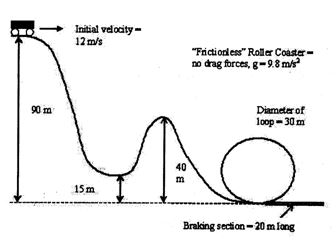Assignment:
The questions refer to the roller coaster in the diagram. The mass of the roller coaster, including passengers = 500 kg. Assume that friction and drag forces are so small they can be ignored.

Question 1. Measured from "ground level," what is the gravitational potential energy of the roller coaster at the top of the first hill (90 meters)?
Question 2. At the top of the first hill, what is the kinetic energy of the roller coaster?
Question 3. If the roller coaster had started from ground level at rest, how much work was done on the roller coaster by the time it got to the top of the first hill? (Assume that there were no friction of drag forces.)
Question 4. What is the speed of the roller coaster at the bottom of the first hill? (when the coaster is 15m above ground level).
Question 5. What is the change in the speed of the roller coaster from when it is 15 meters above the ground, to when it is 40 meters above ground level (the top of the second hill).
Question 6. The roller coaster then gets to the loop. What is the speed of the coaster as it enters at the bottom of the loop?
Question 7. What is the net force on the coaster at the bottom of the loop?
Question 8. What is the normal force of the track on the coaster at the bottom of the loop?
Question 9. What is the normal force on the coaster when it is at the top of the loop? (The coaster is below the track).
Question 10. In the last 20 meter section, a constant braking force is applied to the coaster which brings it to a stop. What is the number of "g's" felt by the passengers? (A "g" is an acceleration equal to 9.8m/s^2).